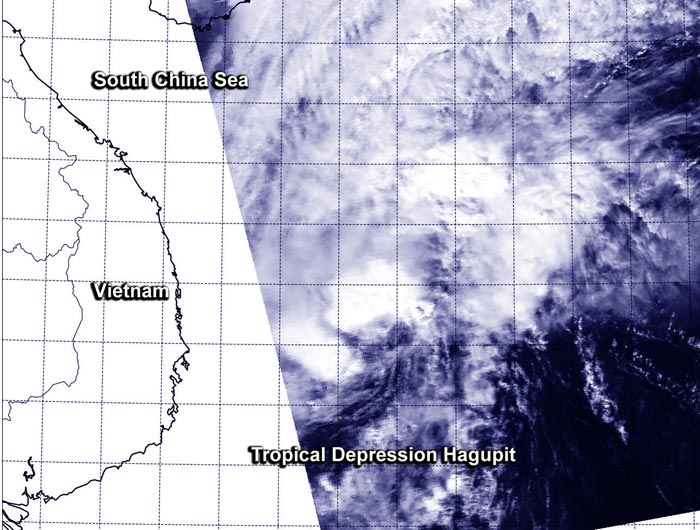NASA Sees Hagupit Weaken to a Depression Enroute to Vietnam

NASA's Aqua satellite passed over Hagupit on Dec. 11 at 05:20 UTC (12:20 a.m. EST) and saw thunderstorms had become fragmented around the circulation center. Image Credit: NASA/NRL
NASA's Aqua satellite passed over Hagupit on Dec. 11 at 05:20 UTC (12:20 a.m. EST) and the MODIS instrument captured a visible image of the storm.
The MODIS image showed that the thunderstorms had become fragmented around the circulation center.
On Dec. 11 at 1500 UTC (10 a.m. EST) Tropical Depression Hagupit's maximum sustained winds dropped to 30 knots (34 mph/55 kph).
It was centered near 12.8 north longitude and 110.9 east latitude, about 314 nautical miles (361 miles/581 km) east-northeast of Ho Chi Minh City, Vietnam. It was moving to the west at 8 knots (9.2 mph/14.8 kph).
The Vietnam National Centre for Hydro-meteorological forecasting has issued a tropical depression warning for southern Vietnam. For the latest forecasts and warnings, visit:
http://www.nchmf.gov.vn/Web/en-US/104/102/24189/Default.aspx
Hagupit is moving west-southwest toward southern Vietnam, where final landfall is expected around Dec. 12 at 0000 UTC. The system is forecast to dissipate quickly after landfall.
Rob Gutro
NASA's Goddard Space Flight Center
Media Contact
All latest news from the category: Earth Sciences
Earth Sciences (also referred to as Geosciences), which deals with basic issues surrounding our planet, plays a vital role in the area of energy and raw materials supply.
Earth Sciences comprises subjects such as geology, geography, geological informatics, paleontology, mineralogy, petrography, crystallography, geophysics, geodesy, glaciology, cartography, photogrammetry, meteorology and seismology, early-warning systems, earthquake research and polar research.
Newest articles

“Nanostitches” enable lighter and tougher composite materials
In research that may lead to next-generation airplanes and spacecraft, MIT engineers used carbon nanotubes to prevent cracking in multilayered composites. To save on fuel and reduce aircraft emissions, engineers…

Trash to treasure
Researchers turn metal waste into catalyst for hydrogen. Scientists have found a way to transform metal waste into a highly efficient catalyst to make hydrogen from water, a discovery that…

Real-time detection of infectious disease viruses
… by searching for molecular fingerprinting. A research team consisting of Professor Kyoung-Duck Park and Taeyoung Moon and Huitae Joo, PhD candidates, from the Department of Physics at Pohang University…




















